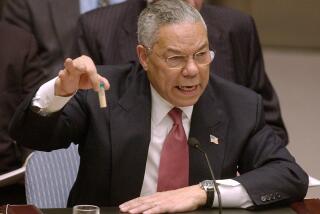PERSONAL PERSPECTIVES ON THE DAY THE WAR BEGAN: JANUARY 16, 1991 : THE STRATEGIST
- Share via
WASHINGTON — Military historians associate the beginning of modern warfare with the industrial revolution and the Napoleonic wars of the late 18th and early 19th centuries. It was then that the ideas of deep strategic penetration and of rapid and overwhelming concentration of force against precise points were developed. On Jan. 16, the world, and particularly the Iraqi military, was introduced to modern warfare at its most advanced level. But even as the events of that day alter the public’s knowledge, even as the world follows a high-tech war, it should brace for a resumption of the warfare of the past--the clash of massive armies on the battlefield.
The initial phase of the air campaign against Iraq was surprisingly “sterile,” given that it was war. The impact of military technology no doubt contributed to the almost surreal feel of the unfolding events. The reportedly overwhelming success of the attacks by American and coalition pilots amplified the evening’s incredulity.
The closest historical parallel to the surprise attack launched against Iraq is the 1967 victory of the Israeli air force over the combined forces of Egypt, Syria and Jordan. In more than 1,000 sorties carried out over two days, Israel’s force of 250 aircraft destroyed more than 400 Arab planes, many of them parked on runways. As successful as that attack was, Israel still lost more than two-dozen aircraft. On Jan. 16, only two allied planes were reported downed.
The range of targets attacked by the U.S.-led aircraft in Iraq and Kuwait was far broader than Israel attempted in 1967. Not only were Iraqi aircraft and airfields hit, but also chemical and nuclear-weapons plants, ballistic missiles, command-and-control centers, weapons depots and the Iraqi air-defense system came under fire.
On the face of it, then, the opening attacks of the Persian Gulf War were even more successful than the Israeli attacks in 1967, a testament to advances in military technology. The destructive capability of precision-guided weaponry, because of its extremely high degree of accuracy, is unprecedented.
Iraq clearly could not have anticipated this late 20th-Century technology and weaponry. Air power was not a prominent factor during its eight-year war with Iran. Neither side possessed air forces capable of causing more than economic damage on soft targets. Nor did either side’s jets provide adequate support to ground forces.
Today’s aircraft is a weapons “platform”--it simply delivers the firepower to the target. This far-reaching revolution was heralded by the extensive use of cruise missiles in the opening campaign against Iraq. Indeed, they underscore a trend that may eclipse the “man in the cockpit.” Similarly, the most threatening weapon in Iraq’s arsenal is not an army of a million men but rather its ballistic missiles.
The rush to proclaim the decisiveness of aircraft technology and precision weaponry in the wake of the attack on Iraq may be premature, however. There is a strong seductive appeal in the clinical manner in which air power was used, producing few coalition casualties while causing substantial damage to Iraqi targets. But it is not a question of whether air power is decisive; rather, it is one of the overall effectiveness of the air attacks in achieving the stated political objectives. Air power, in isolation, is unlikely to bring about a decisive defeat of Iraq.
Barring en masse surrender by Iraq, the coalition will probably have to use ground forces to drive it out of Kuwait. But with complete control of the skies, a successful ground offensive will be that much more rapid and its cost in human life will be that much less. The success of air power has insured the outcome of this conflict.
If the world indeed witnessed a revolution in modern warfare on Jan. 16, the clash of massive armies in and around Kuwait will be a return to war, old-style. That revolution is driving warfare to a style characterized by ever smaller units armed with ever more devastatingly precise weaponry. But the age-old principles of mass, momentum and firepower still, in the end, decide the victor in a ground war.
More to Read
Sign up for Essential California
The most important California stories and recommendations in your inbox every morning.
You may occasionally receive promotional content from the Los Angeles Times.













